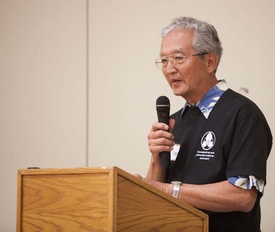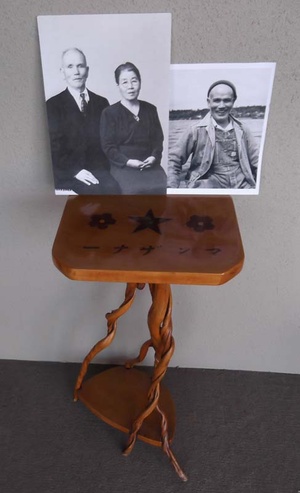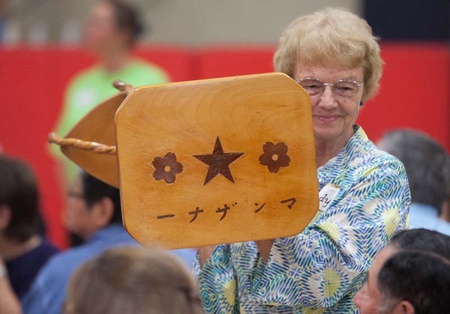The most important reminder that surfaced throughout each chapter in our family’s history was that it all happened on American soil. Despite setbacks, losses, hardships, and interruptions in their lives, they still found fertile ground in which to make a living, to raise children, and to enjoy life with friends in a community that offered opportunities for a good life. I am grateful that they chose to do it on Bainbridge Island!

Wayne Nakata speaking at the Sonoji Sakai Intermediate School on the "Bainbridge Island Bus Tour" (Photo courtesy of Tracy Kumono Photography)
My grandparents, immigrants from Japan, were among many families who settled B.I. in the early 1900s. Grandpa, Jitsuzo Nakata, was born in 1875; Grandma, Shima, in 1887. This picture shows my Grandpa as I remember him best—jolly and upbeat. He taught me several things. I appreciated him as an entrepreneur, farmer, artist, craftsman, and most importantly, as a visionary. There are so many questions I would ask him now as a more appreciative and curious grandson.
In his early 20s, Grandpa was with the Japanese army stationed in Formosa after the Chinese-Japanese War in 1894-95. After finishing his army duties, he decided to leave Japan in 1899. A younger brother of a friend had moved to the Seattle area, so my grandfather decided to come here also. As a single man, he arrived in Tacoma, moved to Bainbridge Island to work at the Port Blakely mill earning $1.30 a day, which included meals and a place to stay.
Eventually, despite his meager earnings, after several years he was able to save enough to buy a lot on Winslow Way by the ravine, where the new art museum is today. He worked day after day, month after month, to reach his goal of operating a barbershop, bathhouse, and later, providing laundry service. His shop was nearly completed in 1905.
The Russian-Japanese war temporarily interrupted Grandpa’s life on Bainbridge, when he was called for army duty once again and had to return to Japan in 1905. Fortunately, on his arrival for duty, the war was over and with no further military duties, he was ready to get married before returning to Winslow. The family matchmaker had already chosen his future mate, although he was not aware of it. One day as he walked into his former neighborhood barbershop for a shave, Grandma and her girl friend were working in the shop. The friend knew of the arrangement, but Grandma was not told yet. As Grandpa was put in a reclining position in the barber’s chair with a hot towel covering his entire face, Grandma’s friend pointed vigorously at Grandpa, getting Grandma’s attention, and at the same time mouthing the words, “This is your future husband!”
On February 17, 1906, they were married in their hometown, Agenosho, a small fishing village in the Prefecture of Yamaguchi, near Hiroshima, in the southwest region of Japan. A month later they began their life on Bainbridge Island as barbers.
Dad was born on January 12, 1907, in their barbershop home on Winslow Way. Six daughters and three more sons followed, with their youngest child, Ken, born in 1926. Raising children, trying to make a living at the barber shop and bath house, and surviving the new world was the life style of our family on Winslow Way.
In the early days laundry service to nearby waterfront summer homes was by means of a rowboat, and later deliveries were made by horse and buggy. All the children helped with the daily chores, attended Eagle Harbor Congregational Church, and Lincoln School in town on Winslow Way and Madison Ave. Life was stable and steady until 1924, when an opportunity came to supplement the family income by purchasing a strawberry farm. The 15 acres were owned and developed by Mr. Sumiyoshi, who was born in Japan. He began growing strawberries in 1909 and built a large two-story farmhouse, which provided a place to can strawberries from his and other nearby farms. By 1917 the canning process at the home could not keep up with the demand, so then the strawberries had to be shipped to a Seattle cannery. By the early 1920s a local cannery was built on Eagle Harbor, close to the farm.
Our family’s purchase of the land was made possible through the long-time friendship and generosity of the Nakao family whose son, of legal age and a U.S. born citizen, signed the ownership papers for our family. This was common practice locally, since at the time state and federal laws prevented immigrants from owning land in the U.S., and Dad, born on Bainbridge Island, was only 17 years old. At 21, four years later, he took ownership under the family name.
One of the most significant days that occurred in our family history was in 1931. That’s when Grandpa had a conversation with Dad after reviewing the decline of the barber-laundry business and recognizing the low yielding strawberry crop that year. Grandpa suggested to Dad, “Maybe you better get a real job! How about asking Mr. Charles Brehmer, the local owner and operator of the meat shop nearby, for a job?” Fortunately, with long-lasting results for our family, Dad got that job as an apprentice making the huge amount of $12 a week.
It was a steady paycheck for the family, and Dad was so enthusiastic about the business that after his completed apprenticeship, he bought the meat business from Charlie in 1935.
During the same period before the meat shop purchase, arranged marriages were scheduled not for one couple but two in the family at the same time: Aunt Jean (Dad’s sister) marrying Uncle Joe (Mom’s brother). It was a double wedding ceremony performed in the farmhouse on October 1, 1933. Although the bridegrooms economized on the minister, they, without the brides’ knowledge, still had to borrow $100 to cover their respective wedding, reception, and honeymoon costs. And the two couples had to share one car to go on their honeymoon!
The business prospered, and a highlight during this period was when Dad was able to pay off the mortgage on the farm property. Grandpa was overcome with tears of joy and jubilation, for he had finally achieved the goal of his family to own land, free and clear, on Bainbridge Island. Another American Dream realized!
Business continued to grow, so plans were made to build a new, larger store on the barbershop lot in 1940. The old barber-laundry shop was torn down. The entire family, including grandparents, Dad’s three brothers, and one sister, all moved into the farm house.
Life was good, stable and steady with a promising future until that eventful day, December 7, 1941. Although our family experienced the most difficult time in their lives then, there were expressions of support, kindness, and inspiration from our Bainbridge Island community before our enforced mass exclusion from our island homes. At the store, most of Dad’s customers had a charge account due at the end of each month. Collecting on each account was a struggle and challenge every month including all the returned, bad, personal checks. It was very gratifying when Dad’s customers who had a charge account all showed up and fully paid off their bills. Even more impressive was that all the bad checks were replaced with good ones.
In March our family was given only a week to settle matters with the store business and the house on the strawberry farm before being evicted and confined at the Manzanar detention center in eastern California. Vadalion (a Filipino family friend) agreed to care for our home and strawberry fields until our return. Another friend tried to continue operating the store during our incarceration, but before our return home, Dad had to sell the business due to the uncertainty of the times.
Close family friends such as the Loverichs were also very supportive by offering their private storage places for our valued personal possessions.
Letters, cards, comfort food, and other gestures of goodwill were given until our departure.
Walt and Milly Woodward, publishers of The Bainbridge Review, took a firm stand supporting the Japanese community, based on the United States Constitution. In their newspaper editorials they opposed the involuntary removal of the Japanese Americans. Their high standard of principle and integrity was expressed with remarkable courage, and they were an inspiration to many who admired and respected the position they held at a difficult time in our community’s history.
Our family’s arrival in Manzanar was on April 1st, and Mom wished it was all a dream and an April Fools’ joke, but reality soon set in. They had to make the best of a difficult situation. Dad offered his experience as a meat cutter, working in the kitchen at the mess hall, and later worked on local farms. Mom worked as a domestic in the homes of the camp administrators. Grandpa worked on one of the camp farms and was always crafting and constructing items for personal use such as a chair or needed shelving from discarded scrap lumber. He made this table during this time.

Family photos on the table that the grandfather made inside the camp. (Photo courtesy of Wayne Nakata)
It is made from scrap wood found in the camp. The legs are of mesquite or sagebrush from the desert. The top is inlaid with Japanese characters, which spell out Manzanar. The two flowers represent Japan, and the star stands for America, the country he loved despite the government order that incarcerated him and his family. When he was still on Bainbridge Island before the war, he had painted stars on the red and white striped barber pole at his shop, which further emphasized his devotion to his adopted country.
One of the first people to pass away at Manzanar was Mr. Murakami, an elderly man who was from the same prefecture in Japan as my grandparents. Grandpa decided to honor him by carving a headstone for his grave. Uncle Ken, who was 16 at the time, drew the outline of the letters, and Grandpa carved the lettering. That headstone still remains there today at the camp cemetery.
The look-a-like barracks, without designated numbers, created situations with unintentional and amusing results. Once in the middle of the night Grandpa returned from the restroom, which was located a block or more away. Assuming he had entered his room, he sat down and wondered who was visiting his family that night. He soon realized he was the unexpected company and quickly excused himself with embarrassment and went off to find his room. On another occasion, in the darkest of nights, he crawled back into his bed and awakened the woman next to him. She was not Grandma! It was Mrs. Yukawa, whose husband escorted Grandpa out the door!
In 1945, after three years of camp life in Manzanar, we were allowed to leave. However, we could not return to Bainbridge Island due to the racial tensions that still existed on the island. Tub and Wanda Hansen, cattle ranch owners near Moses Lake, in eastern Washington, graciously accepted the kindly role of providing for our family a temporary job for Dad and a small cabin to live in on the ranch. At five years old, my thoughts were—great! Riding horses, branding cattle—this is even a better summer camp! Life on a ranch was great fun that summer, and I could have stayed longer, but as racial tensions eased, the chance to finally return to Bainbridge Island came that fall in time for me to enter kindergarten.
Upon our return, we first assessed the family’s overall situation. We still had the farmhouse and property, family members were healthy, and it was time to move on to the future and not dwell in the past.
My grandparents did not live long enough to see the successful business that involved their four sons, and to know that Don, their first grandson, was instrumental in the expansion of the Town and Country Market Corporation. Over the years, many of the descendants of each of their four sons, and some of the Loverich family, have been very active in the development of the business, which is still expanding.
Except for three years during World War II, Jitsuzo and Shima Nakata lived their retirement years at the farm home. She passed on in 1949 at the age of 62, and he lived until 1955, when he was 80 years old. They had both worked very hard all their lives paving the way for their succeeding generations. Thus ended the lives of our pioneer ancestors, who found contentment in America, and enjoyed the blessings of Bainbridge Island.
* * *
* Wayne Nakata spoke at Sonoji Sakai Intermediate School during the Bainbridge Island Bus Tour during JANM’s National Conference, Speaking Up! Democracy, Justice, Dignity on July 4-7, 2013 in Seattle, Washington. For more information about the conference, visit janm.org/conference2013.
Watch the highlight of the bainbridge Island Tour >>
© 2013 Wayne Nakata





